MY FRUSTRATING ROMANIAN SOUVENIR SHEETS
REVIZITED AFTER FORTY YEARS
Victor Manta, PWO, AIJP
This article is a continuation of the article "The encounter with my philatelic youth, fifty years later " 1 and it refers to some souvenir sheets issued by the Romanian Post over a decade, starting by the year 1971.
Before 1971 the stately owned State Commercial Enterprise Philately (ICS Filatelia) strongly limited the number of issues to be sold over the face value to collectors, like the Olympic Games in Innsbruck (1963), Olympic Games in Tokyo and World Cosmonauts (1964). The article mentioned above was dedicated to these issues.
The situation changed radically on July 23, 1971, the day that was and will remain a black one for the Romanian philately, the day when was issued the imperforated souvenir sheet named Soyuz 11, dedicated to the death during their mission of three Soviet cosmonauts. Unlike whatever happened before, this souvenir sheet, followed by others, most of them covering high-interest topics such as the conquest of outer space and the Olympics, could not be purchased legally in Romania , the country on whose behalf it was issued.
This souvenir sheet, dedicated to tragic deaths, represented also a sort of philatelic death for me, because I gave up collecting the topic "Conquest of the outer space." The reason was that to the existing difficulty of procurement of foreign postage stamp suddenly appeared an unexpected and insurmountable obstacle in the procurement of stamps issued by the country in which I lived then.
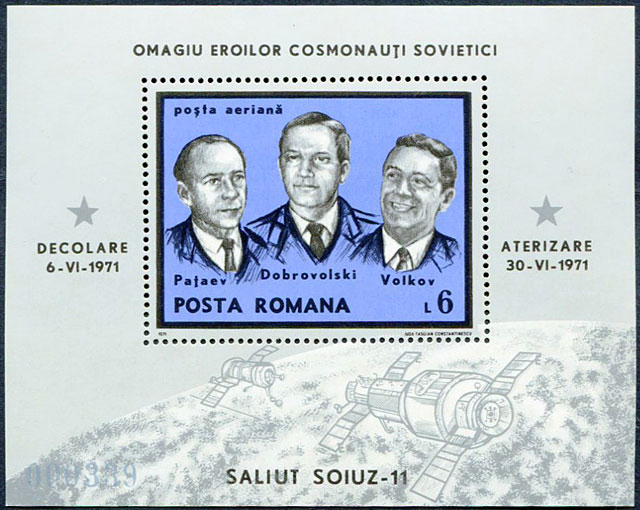
Typically, to sweeten the pill, the souvenir sheets mentioned above were issued in the same time with some perforated ones, which could be purchased at face value at the state philatelic trade. But there was a difference, not devoid of importance for philatelists, namely that of the difference in the print runs. For example, if Soyuz 11 perforate souvenir sheets, Michel Block 85, has been printed in a number of 100 000 copies, its imperforate pair, Michel Block 86, has had a print run of only 12 500 copies. This decreased print run attracted the attention of many philatelists that were willing to have complete collections, but also of some persons, fond at the periphery of philately, who saw in this abnormal situation a source of big and rapid gains.
Something very unusual in those days was that the Soviet authorities acknowledged the death of the three astronauts during the mission, which made ??it possible to issue these S/S, what increased the interest for them.
I display below the images of both souvenir sheets, which I bought on the web in the auctions of a dealer from Germany. In the same time I won the auctions for the chronologically next seven Romanian souvenir sheets, for which I bid as well to alleviate the frustration accumulated during my youth but also to sink deeper into that distant time.
The financial effort to obtain them was not overwhelming, although it was significantly higher than that for the "World Cosmonauts" or the "Tokyo Olympic Games" that I bought for the research on my first article. I mention in passing that Web auctions are interesting as such, and they can be downright thrilling in their final stages. They require prior documentation (consultation of catalogs, finding information on prices paid earlier, etc.), cold blood, patience and self-control. As the French say, perfectly justifiable also for this case, the whole is recommended to be consumed “avec modération.”
The impression I had when I could finally hold in my hands (actually in tweezers) these souvenir sheets for the first time in my life was one that is difficult to describe. I could still remember when I could see for the first, and for a long period the last time, during the years 1971 - 1972, a copy of the Soyuz 11 imperforated souvenir sheet. Then a collector showed it me very quickly, after sneaking out of a small stockbook which he held in the breast pocket of his jacket. I learned from him that he paid for the S/S the amount of Lei 300, which was about a quarter of the monthly salary of a physicist like me during his first year of professional activity.
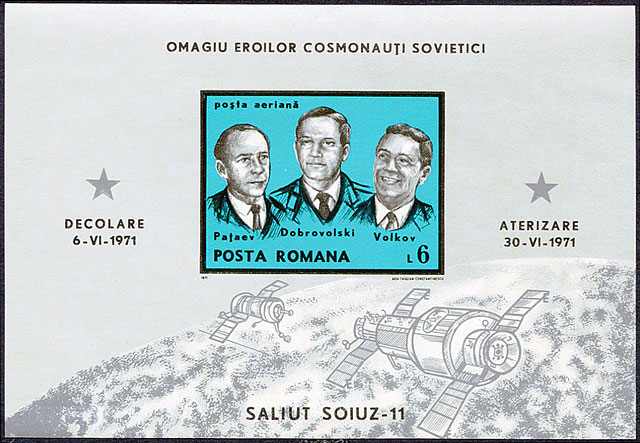
I refrained from asking him where and how he purchased the S/S, and anyway probably he wouldn't have shared this sensitive knowledge with me. What I learned only later, around the year 2000, from a former "shadow" dealer, was that a large number of issued S/S was stolen directly from the stamp factory, that some of perpetrators as well as resellers were caught, tried and sentenced to imprisonment. I found out from one of those resellers that he spent two years in jail and that, quote "all his stock” was confiscated. Here is the place to mention for our Western readers that in the communist Romania the selling and buying of stamps between individuals were prohibited by law, just the barter (swap) being considered an acceptable form of exchange...
The consequence of all these recollections was that I could not feel glad when I met over the years my frustrating souvenir sheets, what the reader will of course understand.
Let us now speak about several aspects that are closer to stamp collecting and, for this reason, more enjoyable. You have surely noticed that the two souvenir sheets have different colors, which was not a bad idea. What surprised me though was that they are very different in size, the imperforated souvenir sheet (130 x 90 mm ??) being by 46% bigger than the perforated one (100 x 80 mm). This increase in surface was not used by the designer (the well known graphic artist Aida Tasgian Constantinescu), who used the background of the perforated souvenir sheet, which she simply expanded to cover the supplementary surface.
The displayed souvenir sheets bear the same, relatively small serial number (!), 000339, which in my opinion makes them more interesting. First of all, let me note that these numbers were printed 2, which makes their digits to appear prominently on the gummed side of the souvenir sheets. I notice that the gum remained flawless after more than 40 years since their issue, which can not be said, for example, about souvenir sheets issued by Hungary in the same era.
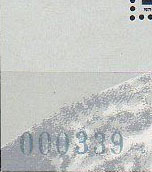 |
 |
The probability for two souvenir sheets with the same number, having very different print runs, to "meet" by chance is extremely small, which makes me think that they have been preselected and then they were offered in pairs for sale. This could be made by the big dealers found abroad or by the Romanaian exporting state enterprise. The pairing by serial number could "happen" also upstream in the stately owned stamp factory.
Note also that where we expect more attention, namely for the imperforated souvenir sheet, the figure "9" at the end of the serial number is shifted downwards, a fact for which I have no explanation, and that raises some questions.
The pair of S/S shown below is dedicated to the World Football (Soccer) Championship from Germany, in 1974, that have the same serial number printed as well on the perforate (Mi. Block 114, print run 150 000 pieces), as on the imperforate one (Mi. Block 115, print run 27 000 pieces). It seem to confirm my suspicions related to the pairing done on the chain manufacturing - sale for the S/S that bear the same serial number.
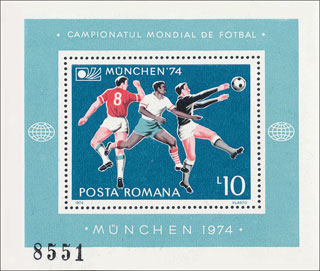
We notice that for these two S/S the serial numbers are relatively high. Just to mention that I bought them from a dealer located in another country than the one from which I bought the S/S Soyuz-11 .
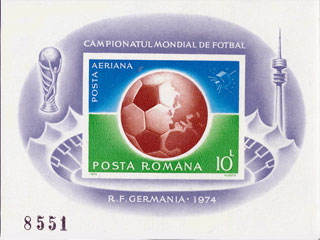
These two S/S have also other outstanding "features." The name of the country in which the competition was held appears, curiously, only on the imperforate S/S, the one having a restricted distribution. Before German reunification in 1990, the West Germany (GFR) name appeared in Romanian as R.F. Germana and of the East Germany (GDR) as R.D. Germana. The name R. F. Germania, that appears on the imperforate S/S, will be officially used in Romania only starting by the years 1990 - 1991. This makes me think that the name of the competition's organizing country that appears on the imperforate S/S was chosen to facilitate the sale of this S/S in the GFR.
The text that appears on the perforate S/S, "MÜNCHEN '74", being accompanied by "Football World Cup", is totaly innacurate because the competition was actually held in not less than eight different cities of West Germany, and in addition in West Berlin. In the football slang we can talk, as it is displayed on the image, about a foul on the goal keeper, and in the ordinary language about errors made intentionally.
The position that the major international stamp catalogs took, and still take in relation to these souvenir sheets is interesting. From memory, the famous Swiss Zumstein Europa Ost catalog, that disappeared a longer time ago, mentioned the existence of these souvenir sheets, without evaluating and reproducing them, and by printing at the beginning of the text description a black diamond, that warned that these issues weren't recommended. Nowadays the Scott catalog mentions and values these S/S without assigning numbers to them. In addition to Scott, Michel catalog presents their images and assign individual numbers to each of them.
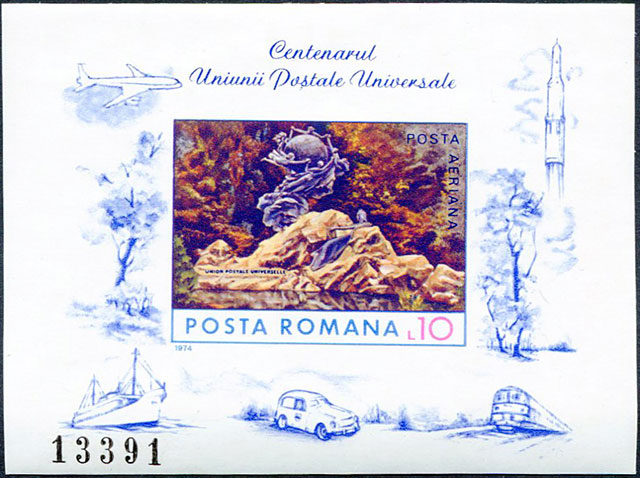
A souvenir sheet that I purchased on the same occasion, and that caught my attention, is the one issued on May 15, 1974. It is dedicated to the Centenary of Universal Postal Union, Michel Block 113, 30 000 numbered souvenir sheets. From the Scott catalog 2009 we learn that “This sheet is not know to have been sold to the public at post offices.” 3 This information coincides with what the author knows, just that that the same is true for many other imperforated souvenir sheets, issued during the period that I mentioned at the beginning of this article, sheets that were sold only outside of Romanian borders. Unfortunately, I could not find anywhere in Scott or Michel such a general statement.
Even if these souvenir sheets were issued and sold in the 1970s in an unacceptable manner, they are part of Romanian philatelic heritage and therefore represent today valid object for collecting and studying. Finally, I would like to express my belief that many of these souvenir sheets, expatriates by force under an oppressive regime, will slowly return to their country of origin and they will find their place in the stock books of Romanian stamp collectors, along with other modern Romanian souvenir sheets, prized by connoisseurs, like the Vlad Tepes S/S (Bucharest - 500 years, print run 30 000) and the Centennial of the Moldova stamps, overprinted (20 000), both issued in 1959.
Lower Manhattan, New York City, USA, November 2013 - April 2014
References
- Appeared in Romanian in the printed magazine philatelica.ro Nr. 29, 2013, and in English on my website under http://www.marci-postale.com/History/Printing/50-years-after.htm
- According to Michel catalog 2013: "Kontrollnummern in Bdr. (Buchdruck - VM) eingedruckt"
- "An airmail UPU imperf souvenir sheet of one (10 l) exists. This sheet is not known to have been sold to the public at post offices." Scott 2009, Volume 5, a note that appears after Scott # 2482.